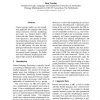Free Online Productivity Tools
i2Speak
i2Symbol
i2OCR
iTex2Img
iWeb2Print
iWeb2Shot
i2Type
iPdf2Split
iPdf2Merge
i2Bopomofo
i2Arabic
i2Style
i2Image
i2PDF
iLatex2Rtf
Sci2ools
ACL
2006
2006
Integrated Morphological and Syntactic Disambiguation for Modern Hebrew
Current parsing models are not immediately applicable for languages that exhibit strong interaction between morphology and syntax, e.g., Modern Hebrew (MH), Arabic and other Semitic languages. This work represents a first attempt at modeling morphological-syntactic interaction in a generative probabilistic framework to allow for MH parsing. We show that morphological information selected in tandem with syntactic categories is instrumental for parsing Semitic languages. We further show that redundant morphological information helps syntactic disambiguation.
| Added | 30 Oct 2010 |
| Updated | 30 Oct 2010 |
| Type | Conference |
| Year | 2006 |
| Where | ACL |
| Authors | Reut Tsarfaty |
Comments (0)

